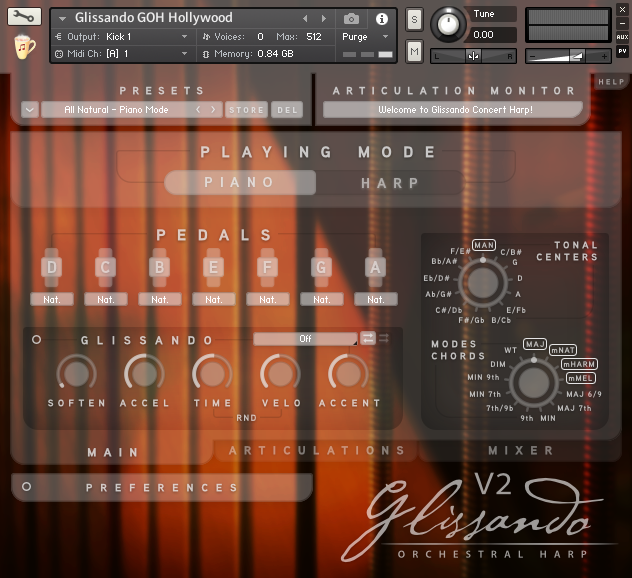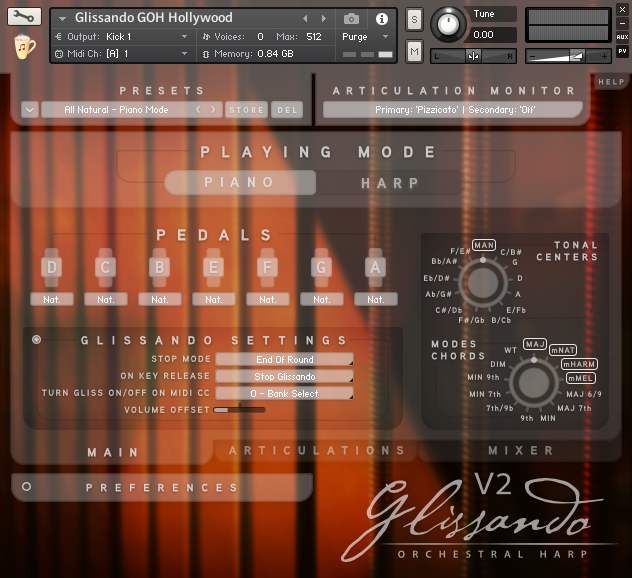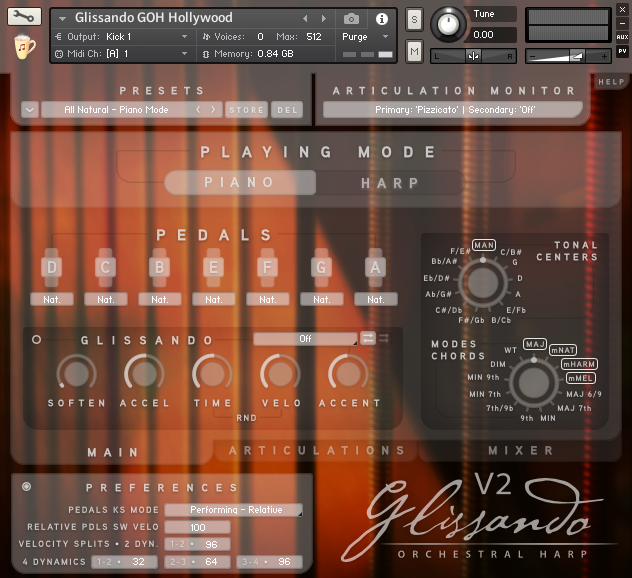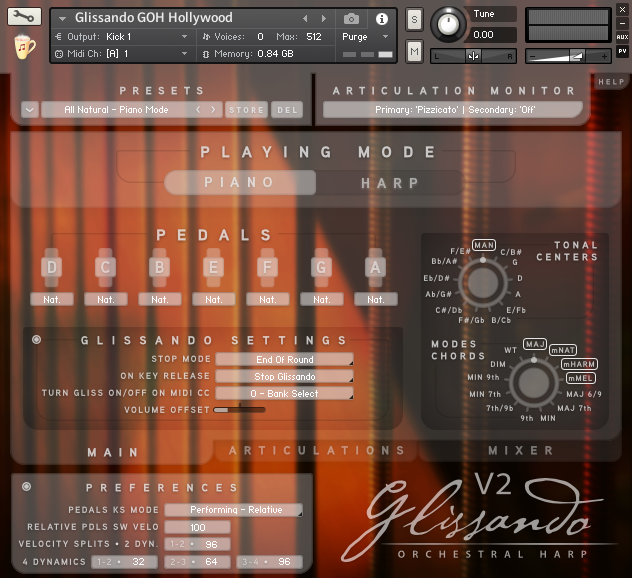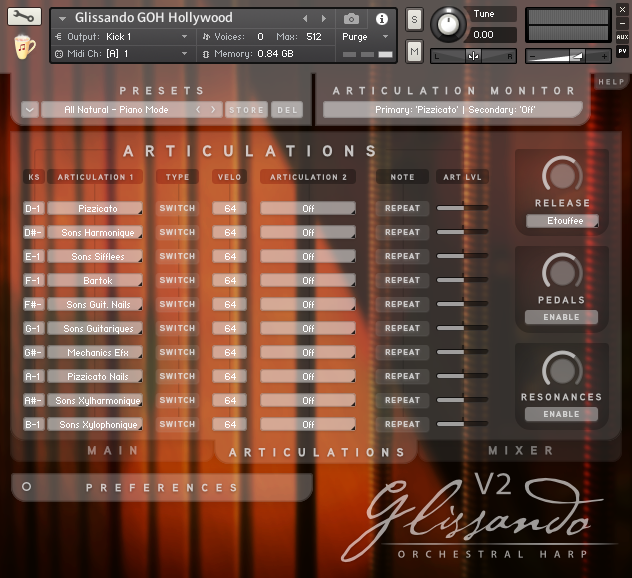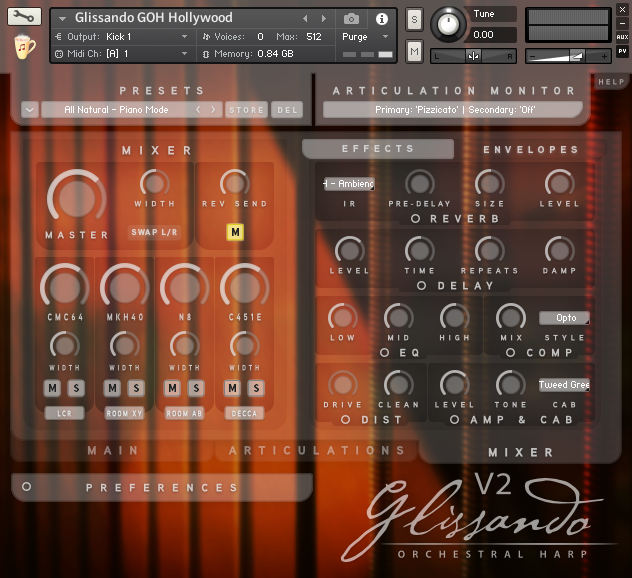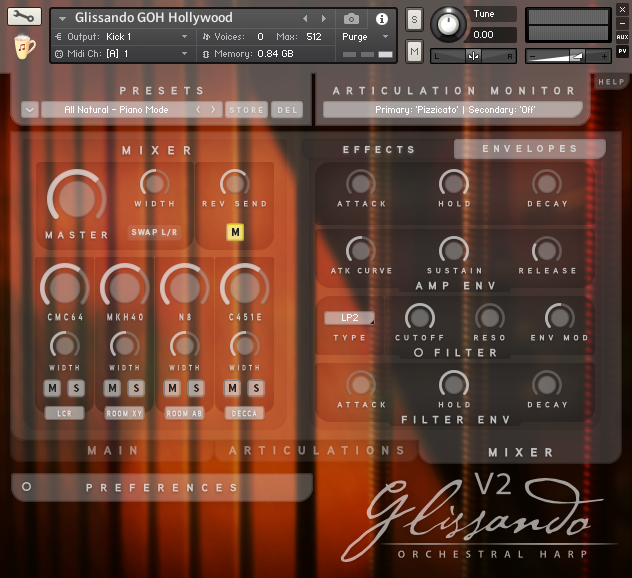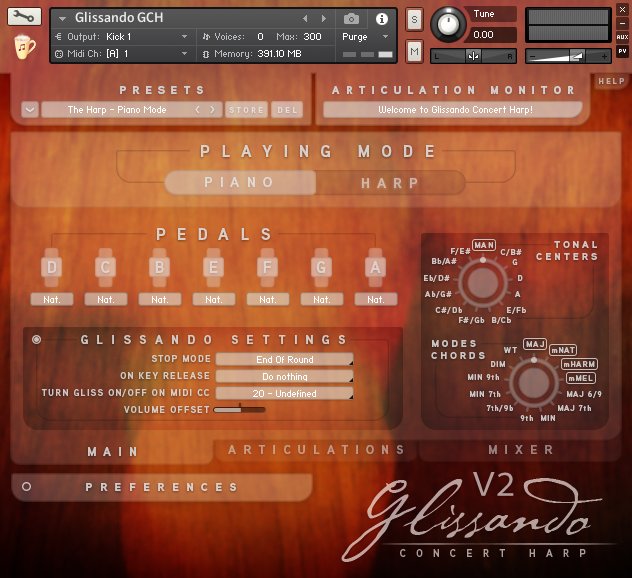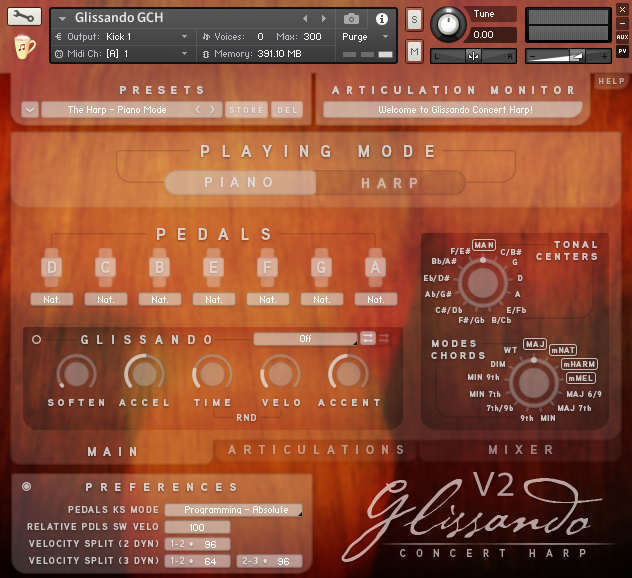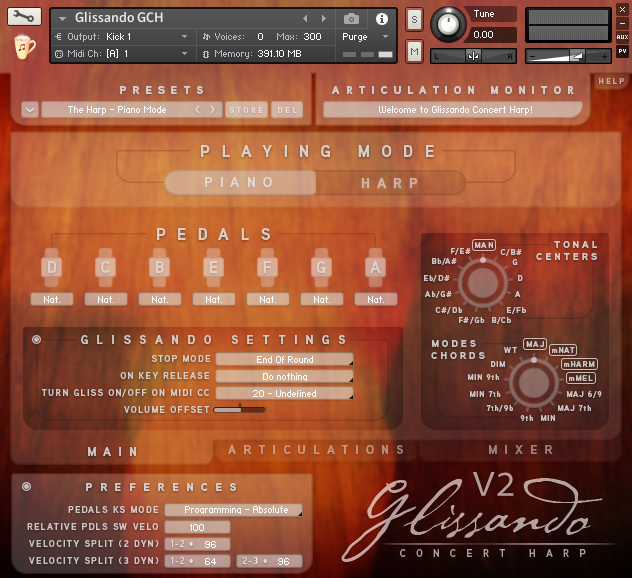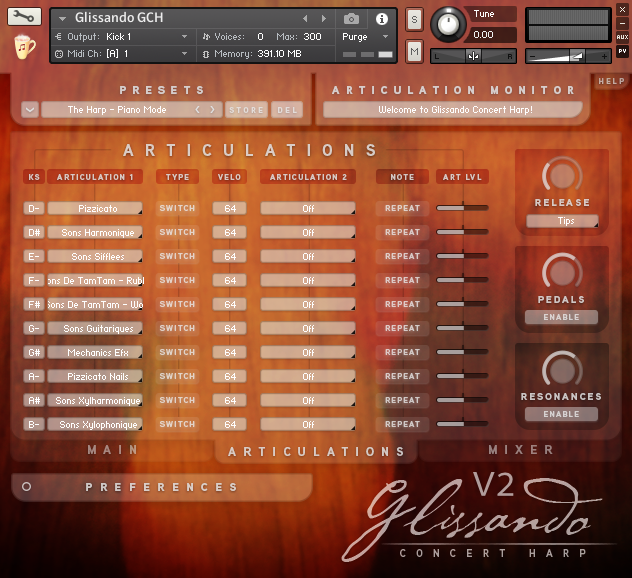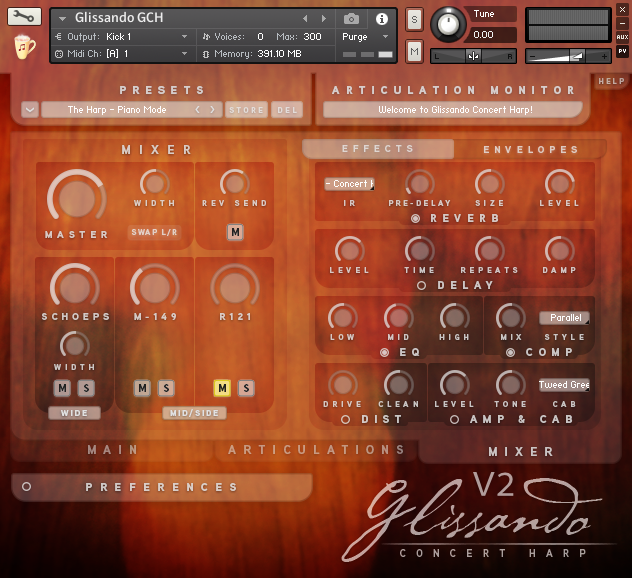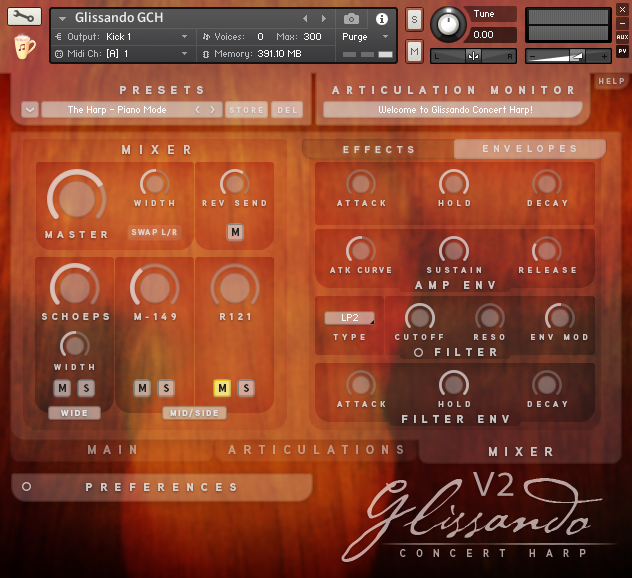Glissando Harps for Kontakt
/Two complete and flexible Classical Harps
Glissando Harps features Camac and Salvi 47-string concert harps sampled in full detail. Each Harp was sampled in a different venue and with different setups in order to augment flexibility and usage scenarios.
GLISSANDO ORCHESTRAL HARP - GOH
GLISSANDO CONCERT HARP - GCH
What’s New
A totally new harp, a Salvi concert harp, aptly named Glissando Orchestral Harp, was added to the original Glissando Concert Harp.
Please enjoy some pics stolen during the sessions for Glissando Orchestral Harp.
Video - Quick Starts
Featuring 4 short videos: Glissando, Harp/Piano modes, Articulations management and Sounds.
Please watch in HD, otherwise the sound quality will be deeply compromised
Audio Demos
This is a selection of audio demos for Glissando Harps.
Demos were created by Jordan Rudess, Roland Seph Erulo, Felice Tazzini, Nicola Pastori, Jay Asher, Federico Mazzei and Enrico Goldoni and mixed by us (apart from Jordan’s demo which materialized in our email box one morning).
Some demos are also presented with the Harp soloed to get an even better idea of its sound and articulations.
GOH stands for Orchestral Harp and GCH stands for Concert Harp.
Fidbak Audio’s embedded player is one of the few on the market to allow for high quality streaming (native WAV).
Infinite Glissandos - a first for samples harps
The very reason we decided to embark in sampling a concert harp in 2012 was to achieve a flexibility unknown in sampled harps. The sound of harps is unmistakably linked to the Glissando technique, where the harpist runs her/his fingers across the strings creating a dreamy and catchy sound unique to the instrument.
Our Glissando engine lets you play Glissandos at any speed, in any tonal center and setting playable on a real harp.
Any Tuning, any Scale, any Chord
When using the Glissando Mode you're left with only the white keys (as the harp features 7 strings per octave) and change the tuning of each string by switching the positions of the Pedals via MIDI or GUI. We created a selection of the most used tunings in the section on the right to give you a quick way to get the Glissando you want.
Speed and Intensity
Turn on Glissando Mode, play a starting note, then play an ending note. The Glissando starts right away.
Press D#0 to stop or C#0 to quit Glissando mode.
The time difference between the two notes will tell the engine the speed of the Glissando. The relative velocities will be used to create eventual crescendos and decrescendos.
Use the ModWheel to change the velocity/intensity of the Glissando in real time.
Use the Pitch Bend to slow down or speed up the Glissando in real time.
Glissando Modes
Select one of 7 Glissando Modes via the menu.
Details
Fine tune the Glissando:
Soften will raise the attack time to emulate a Glissando played with lightly on the tips of the fingers
Accell accelerates or decelerates the glissando along its duration
Accent tells the engine how much accent to give to the Start/End notes when one of the Accent modes is selected
Randomize Time and Velo introduce a randomization in the timing and velocity between notes giving the Glissando a more human-like response
Playing Modes
This harp instrument can be played in two fashions:
PIANO MODE: play the instrument just like you would play a piano
HARP MODE: play using only the white keys and modify their tuning using the Pedal keys (C0 to B0)
In both modes, use the Sustain pedal to sustain notes indefinitely like the harp is supposed to do, or release the pedal and play every note in a Staccato fashion with life-like release sample trails.
The user interface is thought out to be easy and quick to learn and use while featuring the power-user tools some of us love to tweak when working with deeply sampled instruments.
Articulated Customs
Customize your playing using the Articulations Panel:
Assign or turn off any of the 10 available Key Switches for Articulations management
Available Key Switches are: D0 to B0 in Piano Mode, black keys from F#0 to D#2 in Harp Mode
Make any of the Key Switches a Two-Way Switch or a Temporary Switch
Optionally load a Second Articulation to be activated in place of the first when playing harder than a freely settable velocity level
Use the Note Repeat mode to play fast repetitions (on Note Off you will have another Note On event playing automatically)
Set the relative level of each single Articulation
Select the type and level of the Release Samples
Activate and set the level of the natural string Resonances
Set the level and status of Pedal noises
List of Articulations
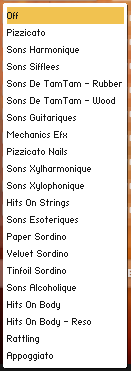
Pizzicato: this is the most common playing technique. Range is C1 to G7 on both Harps
Sons Harmonique: harmonics. Range is A2 to C6 on both Harps
Sons Sifflés: sound produced by rubbing the fingers along the length of the strings. Mostly on bass strings. Here they are mapped on C1-D1. Not a tuned sound
Sons De TamTam - Rubber: sound produced by hitting the strings with a rubber stick. Range is C1 to C7 - Glissando Concert Harp GCH ONLY
Sons De TamTam - Wood: sound produced by hitting the strings with a light wooden stick. Range is C1 to C7 - Glissando Concert Harp GCH ONLY
Sons Guitariques: also called Prés De La Table - is the sound produced by playing the string right next to the lower part of the body. Sound is guitar-like and more brilliant. Range is GCH: A2 to F5, GOH: A2 to C6
Mechanics Efx: sound produced by playing the strings between their mechanics. Range is C1 to E6. A randomly tuned sound
Pizzicato Nails: sound produced by playing the strings with the nails rather than with the finger tips. Range is GCH: A2 to G7, GOH: C1 to G7
Sons Xylharmonique: sound produced by playing the harmonics muffled right after the attack. Range is A2 to C5 on both Harps
Sons Xylophonique: sound produced by muting the string at its end and plucking it with the other hand. Sound is of course muffled and warmer. Range is A2 to G7 on both Harps
Hits On Strings: sound produced by hitting and releasing the strings immediately with both hands. Range is A1 to G2. Not a tuned sound
Sons Ésoteriques: a special technique involving the use of pedals as an effect. Range is A1 to G2. Not a tuned sound
Paper Sordino: sound produced by interweaving the strings with paper ribbons. Range is C1 to C5 on both Harps
Velvet Sordino: sound produce by interweaving the strings with velvet ribbons. Range is GCH: C1 to C4, GOH: C1 to C7
Tinfoil Sordino: sound produced by interweaving the strings with tinfoil ribbons: Range is GCH: C1 to E5, GOH: C1 to C5
Sons Alcoholique: sound produced by rubbing the strings with a piece of cotton imbued with alcohol. Range is C1 to G6. A randomly tuned sound - Glissando Concert Harp GCH ONLY
Hits On Body: sound produced by hitting the body of the Harp in different positions with fingers, open and closed hand. The other arm stops all strings from resonating. Range is GCH: C1 to B2, GOH: C1 to D3
Hits On Body - Reso: sound produced by hitting the body of the Harp in different positions with fingers, open and closed hand. The strings are left free to resonate. Range is GCH: C1 to B2, GOH: C1 to D3
Rattling: sound produced by playing pizzicato with the harpist wearing a noisy jewel at her wrists. Range is C1 to G7 - Glissando Concert Harp GCH ONLY
Appoggiato: sound produced by playing pizzicato and resting the finger on the next string rather than floating it. Range is C1 to G7
Bartok: sound produced by playing pizzicato near the lower part of the body and letting the finger hit the body itself, producing a very percussion-like and aggressive sound. Range is A2 to C7 - Glissando Orchestral Harp GOH ONLY
Sons Guitariques Nails: also called Prés De La Table Nails - is the sound produced by playing the string right next to the lower part of the body with the nails rather than the finger tips. Sound is guitar-like and more brilliant. Range is A2 to C6 - Glissando Orchestral Harp GOH ONLY
Sons Xylophonique Open: sound produced by muting the string at its end and plucking it with the other hand, then releasing the muting finger right after the note has been plucked. Sound is slightly muffled and warm. Range is A2 to G7 - Glissando Orchestral Harp GOH ONLY
To these 23 Articulations, add the string Resonances, the 2/3 types of release trails (finger nails, tips and Etoufee) and the sound of stopping the strings with the hand which is produced automatically when releasing the Sustain Pedal.
Mix, Effect and Reverb, with class
The mixer module allows you to balance the mics and apply effects like Delay, EQ, Compression, Distortion and Amp/Cab.
The IR Reverb module in our engine currently features 39 unique proprietary impulse responses. These are originated from vintage plates, hardware and coveted real rooms, which, when used with the harp, push the limits of what can be done with this instrument.
Sound Design with fun
The Mixer page features a section dedicated to envelopes and filters.
Control the Amplitude Envelope with precision using an AHDSR envelope with the addition of the Attack Curve parameter.
Choose among 4 filter types - low pass 2 and 4 poles, band pass and high pass 4 poles - with MIDI CC# assignable Cutoff, Resonance and Envelope Modulation.
Use an intuitive AHD Envelope to influence the filter cutoff via Env Mod.
Screenshots
Ready-to-go
26 (GCH) + 50 (GOH) = 76 global mix-ready factory presets ease your way into using this instrument, or create and save your own.
The Recordings
For our Concert Harp we selected a warm mid-sized room to record the Camac: we wanted to have a flexible sound, one that fits many different styles and scenarios.
All recordings were done using a pair of Schoeps CMC6 (with matched MK4 capsules) in a stereo AB configuration (wide stereo) and a Neumann M149 tube in cardiod mode as the Mid and a Royer R121 as the Side of a MidSide pair. Vovox cables were run direct to a Millennia HV3D-8 preamp and to an Apogee Symphony converter set at 96KHz/24bit.
For our Orchestral Harp, instead, we went to one of the best recording live rooms in Europe: Sotto Il Mare Recording Studios near Verona (Italy), a room with a wonderful and lush sound perfect for when you need to position an harp in an orchestral scenario, both as accompanist and as a soloist.
There, we set up this wonderful Salvi harp with 8 different sets of microphones which we later combined in five “movie-city-named” nki instruments. An LCR (wide AB + central mono) with Schoeps CMC64 and Soundelux U195, the mono Soundelux U195 by itself, another wide AB with ribbon AEA N22 matched pair. On one side of the harp. On the other side: a tube mic Blumlein setup using a Wunder Audio CM7 pair, an AB with Soyuz SU013. Distant miking setups: a frontal, on axis, XY captured with a Sennheiser MKH40 pair, a really wide AB with ribbon AEA N8 and a Decca trio consisting of three AKG C451E with CK22 omni capsules.
Experience and Quality you can tell
We released our first sample library in 2003, with Scarbee.
We know sampling.
We know how to turn a recording session into a set of coherent, greatly playable sampled instruments. Not just a collection of sounds. This effort needs a lot of love for the instruments, preparation, setup, tuning, time, ear, knowledge, dedication and experience.
Our samples have been used on countless tracks in the last 13 years, counting on an ongoing success still sprawling from our first library, Imperial Drums, re-released in BFD format through FXpansion at the end of 2013, our ever-growing product line and the large large number of companies we worked with along the years: Native Instruments, Ableton, Steinberg, Arobas, Cakewalk and Presonus to name just a few.
119.00 USD
(list price 169.00 USD)
Special Upgrade pricing (50% off) for Glissando Concert Harp registered users
CONTACT US
DISCLAIMERS:
- this Instrument requires the FULL RETAIL VERSION OF NI KONTAKT 5.5.2 or higher
- this Instrument DOES NOT WORK with the Free Kontakt Player
- this Instrument may be acquired only in downloadable format, download size is about 20 Gigabytes, so expect longer download times on slower connections
Features
2 fully sampled Harps
19.3 GB of compressed samples content (54 GB uncompressed)
8244 (GCH) + 19312 (GOH) = 27556 samples
GCH: 2 microphone sets: Stereo AB with Schoeps CMC6 mics and MidSide Stereo with Neumann and Royer mics
GOH: 8 microphone sets, including ribbons, tube and Decca tree
sampled in full detail: up to 6016 samples per articulation and up to 4 round robin
Pizzicato sampled with 3 (CGH) and 4 (GOH) dynamic layers
recorded in a warm mid-size room + large and lively studio to widen the potential applications
23 Articulations
up to 3 types of release samples
Independent management of the instrument's resonances
warm and precise sound, recorded through Millennia, Neve and Heritage Audio preamps and Apogee Symphony converters
advanced management thanks to our custom advanced scripting engine
recorded at 24 bit / 96 KHz, released at 24 bit / 44.1 KHz
Kontakt Features
read the dive-in manual for the Kontakt version here
custom graphics with multi-panel access to every detail of the instrument
2 playing modes, Harp and Piano
exclusive Glissando engine
manage Pedals like an harpist
easy access to the most used Modes and Chords
build your own Articulation Set
full effects section
expand the sound-scape of the harp with envelopes and filters
intelligent voice management
26 + 50 global factory presets
up to 4 round robins
39 custom IR reverbs


